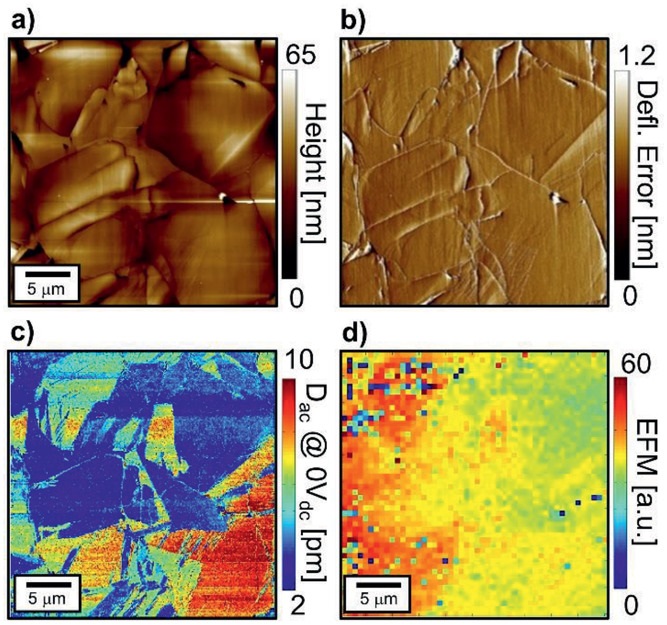Solid state electrolytes (SSEs) are interesting materials that could potentially replace the currently used organic electrolytes in lithium‐ion batteries (LIBs). *
Electrochemical strain microscopy (ESM), a research technique based on atomic force microscopy (AFM), was developed to locally probe ion movement in electrodes based on electro-chemo-mechanical coupling measure through the AFM cantilever deflection. It can be used to characterize Li-ion mobility in energy materials with extremely high spatial resolution. *
The main challenge with ESM is its nonquantitative nature due to complex AFM cantilever dynamics in contact mode when performed on resonance as well as signal contribution that are not necessarily related to ions such as electrostatic forces.*
In the article “ Signal Origin of Electrochemical Strain Microscopy and Link to Local Chemical Distribution in Solid State Electrolytes “ Nino Schön, Roland Schierholz, Stephen Jesse, Shicheng Yu, Rüdiger‐A. Eichel, Nina Balke and Florian Hausen investigate the exact signal formation process of electrochemical strain microscopy (ESM) when it is applied on sodium super ionic conductor (NASCIO)-type solid state electrolytes containing Na- and Li-ions.*
In their research the authors correlatively use various scanning probe microscopy (SPM) based microscopy techniques together with scanning electron microscopy (SEM) and Energy Dispersive X-Ray Spectroscopy ( EDX ) at identical positions of the solid state electrolyte LATP.*
They find that changes in the dielectric properties are responsible for the detected contrast in the deflection of the AFM cantilever instead of a physical volume change as a result of Vegard’s Law. The AFM cantilever response is strongly reduced in areas of high sodium content which is attributed to a reduction of the AFM tip-sample capacitance in comparison with areas with high lithium content.*
This is the first time a direct link between electrostatic forces in contact mode and local chemical information is demonstrated on SSEs. The results presented in the article open up the possibility to learn more since dielectric properties are sensitive to subtle changes in local chemical composition.*
NANOSENSORS conductive Platinum-Iridium coated PointProbe® Plus PPP-EFM AFM probes were primarily used in the research for this article.

a) Topography, b) deflection error, and c) corresponding cantilever deflection change (Dac) map of a 30 µm × 30 µm area of LATP. d) Noncontact EFM amplitude map in the same area.
*Nino Schön, Roland Schierholz, Stephen Jesse, Shicheng Yu, Rüdiger‐A. Eichel, Nina Balke, Florian Hausen
Signal Origin of Electrochemical Strain Microscopy and Link to Local Chemical Distribution in Solid State Electrolytes
Small Methods, Early View, Online Version of Record before inclusion in an issue 2001279
DOI: https://doi.org/10.1002/smtd.202001279
Please follow this external link to read the full article: https://onlinelibrary.wiley.com/doi/10.1002/smtd.202001279
Open Access The article “Signal Origin of Electrochemical Strain Microscopy and Link to Local Chemical Distribution in Solid State Electrolytes” by Nino Schön, Roland Schierholz, Stephen Jesse, Shicheng Yu, Rüdiger‐A. Eichel, Nina Balke, Florian Hausen is licensed under a Creative Commons Attribution 4.0 International License, which permits use, sharing, adaptation, distribution and reproduction in any medium or format, as long as you give appropriate credit to the original author(s) and the source, provide a link to the Creative Commons license, and indicate if changes were made. The images or other third party material in this article are included in the article’s Creative Commons license, unless indicated otherwise in a credit line to the material. If material is not included in the article’s Creative Commons license and your intended use is not permitted by statutory regulation or exceeds the permitted use, you will need to obtain permission directly from the copyright holder. To view a copy of this license, visit http://creativecommons.org/licenses/by/4.0/.